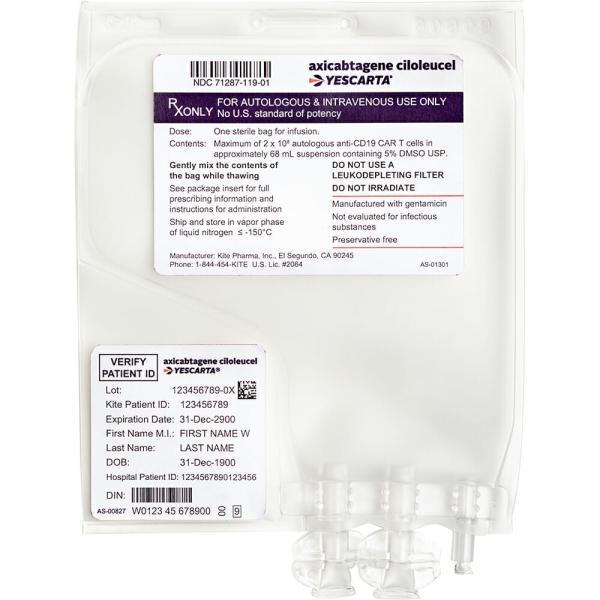Axicabtagene ciloleucel Disease Interactions
There are 5 disease interactions with axicabtagene ciloleucel.
Drugs directed against B cells (applies to axicabtagene ciloleucel) hepatitis B reactivation
Major Potential Hazard, Moderate plausibility. Applicable conditions: Infectious Hepatitis
The use of drugs directed against B cells, such as axicabtagene ciloleucel, and tisagenlecleucel is associated with hepatitis B reactivation, some cases have resulted in fulminant hepatitis, hepatic failure, and death. Close monitoring is recommended when using these agents in patients with a history of hepatitis infection. It is recommended to screen patients for HBV, HCV, and HIV in accordance with clinical guidelines before collection of cells for manufacturing.
Drugs directed against B cells (applies to axicabtagene ciloleucel) infections
Major Potential Hazard, Moderate plausibility. Applicable conditions: Infection - Bacterial/Fungal/Protozoal/Viral
Drugs directed against B cells, such as axicabtagene ciloleucel, and tisagenlecleucel should not be administered to patients with clinically significant active systemic infections. Severe or life-threatening infections, including febrile neutropenia, were observed in patients after treatment with these agents and may be concurrent with Cytokine Release Syndrome (CRS). It is recommended to monitor patients for signs and symptoms of infection before and after infusion and administer prophylactic antimicrobials as appropriate. Counsel patients to seek immediate medical attention should signs, or symptoms of CRS occur at any time. At the first sign of CRS, institute treatment with supportive care according to medical practices.
Drugs directed against B cells (applies to axicabtagene ciloleucel) inflammatory disorders
Major Potential Hazard, Moderate plausibility. Applicable conditions: Autoimmune Disorder
Drugs directed against B cells, such as axicabtagene ciloleucel, and tisagenlecleuce should not be administered to patients with inflammatory disorders. Cytokine Release Syndrome, including fatal or life-threatening reactions, occurred in patients receiving these agents. Axicabtagene ciloleucel and tisagenlecleuce are CD19-directed genetically modified autologous T cell immunotherapy that bind to CD19-expressing cancer cells and normal B cells and through a series of cascades, lead T cell activation and secretions of inflammatory cytokines.
Drugs directed against B cells (applies to axicabtagene ciloleucel) neurological toxicities
Major Potential Hazard, Moderate plausibility. Applicable conditions: Neurologic Disorder
Neurologic toxicities, that were fatal or life-threatening, occurred following treatment with drugs directed against B cells, such as axicabtagene ciloleucel, and tisagenlecleucel which may be concurrent with Cytokine Release Syndrome (CRS) or after CRS resolution. Care should be exercised when using these agents in patients with neurologic disorders. It is recommended to monitor patients for signs and symptoms of neurologic toxicities after infusion and provide supportive care and/or corticosteroids as needed.
Drugs directed against B cells (applies to axicabtagene ciloleucel) vaccination
Moderate Potential Hazard, Moderate plausibility.
The safety of immunization with live viral vaccines during or following treatment with drugs directed against B cells, such as axicabtagene ciloleucel, and tisagenlecleucel has not been studied. Vaccination with live virus vaccines is not recommended for at least 6 weeks prior to the start of lymphodepleting chemotherapy, during treatment, and until immune recovery following treatment with these agents.
Switch to professional interaction data
Axicabtagene ciloleucel drug interactions
There are 309 drug interactions with axicabtagene ciloleucel.
More about axicabtagene ciloleucel
- axicabtagene ciloleucel consumer information
- Check interactions
- Compare alternatives
- Latest FDA alerts (3)
- Side effects
- Dosage information
- During pregnancy
- Drug class: miscellaneous antineoplastics
- Breastfeeding
- En español
Related treatment guides
Drug Interaction Classification
| Highly clinically significant. Avoid combinations; the risk of the interaction outweighs the benefit. | |
| Moderately clinically significant. Usually avoid combinations; use it only under special circumstances. | |
| Minimally clinically significant. Minimize risk; assess risk and consider an alternative drug, take steps to circumvent the interaction risk and/or institute a monitoring plan. | |
| No interaction information available. |
See also:
Further information
Always consult your healthcare provider to ensure the information displayed on this page applies to your personal circumstances.


